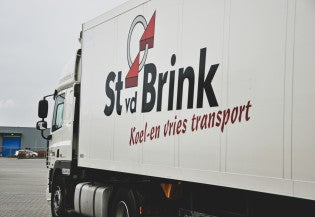Load Securing Beverage Transport
November 17, 2023 – Matthew Neumeier

Load securing in beverage transport
The best way to achieve a tailor-made cargo securing system is good cooperation between manufacturer and user. An example of this is the system of securing beams we have manufactured for transport companies such as St. van den Brink & Zn in Ermelo.
Here is a case study for beverage transportation
St. van den Brink & Zn specializes in the transport of temperature-controlled products. Besides supplying supermarkets, it operates for a number of leading companies in dairy, foodservice and non-food retail. Every day, 250 vehicles are in action for this purpose. Supermarkets are supplied with milk, among other things.

The case study: drinks in carts
The milk carts are in carts weighing about 400 kg each. Several dozen such carts can fit in a trailer. The carts were secured by means of high-quality aluminum beams that are fastened across the width of the trailer and locked into load securing rails that are attached horizontally to the trailer wall. In itself, this is an excellent cargo securing system, which also offers the possibility of attaching a double load floor, for example. But a limitation of the system is its weight and strength. The beams must be manageable for the driver, which means they should not exceed 20 kg. But they must be strong enough to secure the load.
The type 1839 beams used have a weight of about 15 kg each, an LC (lashing or thrust capacity) of 900 daN and a breaking strength (BS) of 1,800 daN in the horizontal direction. With three rails at different heights per trailer, a total load securing capacity of 2,700 daN could be achieved This, however, proved insufficient for the milk carts. As these carts move slightly during driving, much higher dynamic forces briefly occur on the lashing beams.
Bent beams and damaged rails were the result. However, using heavier beams to achieve a higher breaking strength did not turn out to be a good option. They would become too heavy for the driver to apply smoothly in the loading area. We therefore came up with a smarter system.

The solution for beverage transport
Our engineers analyzed the problem and came up with a surprisingly simple and cost-effective solution. First of all, the tie-down beams turned out to be virtually non-existent for double loading. This meant that no vertical loading had to be taken into account. The beam was simply turned a quarter turn so that the wide and therefore strongest side was now horizontal.
In addition, the beams were fitted with robust sliding pieces with two hooks on each side to lock them into the load retaining rails. This resulted in much better force distribution, extra strength and also less wear on the rails. The designed type 1839HDSEC beams have an LC of 2000 daN and a BS of 4000 daN each, so with three beams on top of each other they have a total load securing capacity of 6000 daN. They weigh barely more than the beams used previously to remain manageable for drivers.
While trying out the new beams, another problem surfaced. The beams are slightly adjustable in length to fit between the rails. Drivers sometimes took advantage of this feature to apply a beam at an angle, for example if one row of trolleys was longer than another. This was solved by equipping the trailers with both types of beams the 1839 and the 1839HDSEC, the stronger ones for even rows and a few lighter ones for securing an extra cart, if necessary, as the lighter ones are suitable for securing a single trolley.

Dekra certificate
We have tested the new materials extensively, but there are no official standards for these beams as there are for lashing straps and chains. However, we do make use of the possibility of acquiring a certificate from Dekra in Germany. This is particularly important for haulers driving to Germany. The lashing equipment is then given a Dekra or GS label, which shows that the type has been inspected.
Do you also have a problem transporting certain goods? Then contact us today for a free consultation to create a tailor-made solution.



